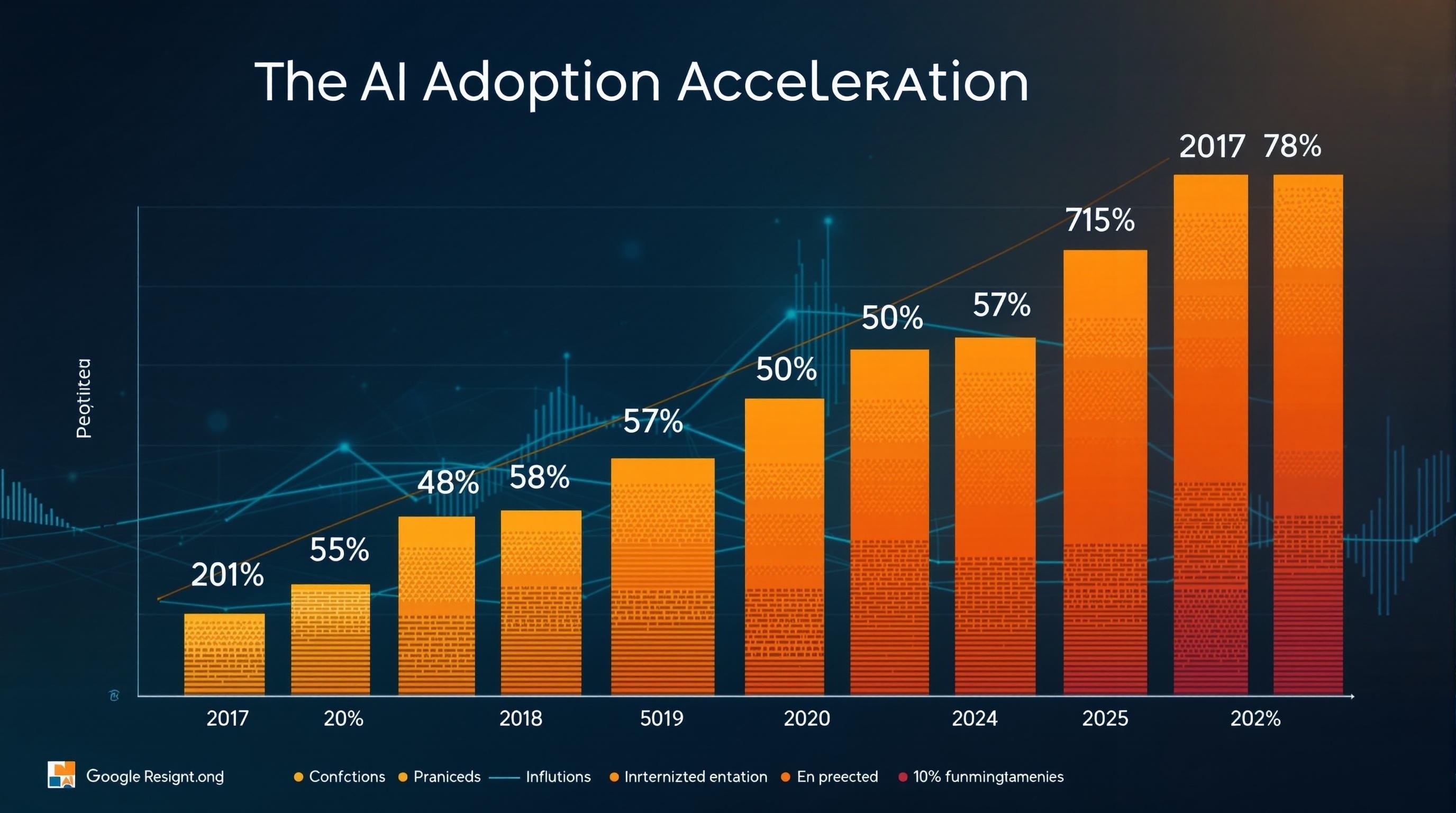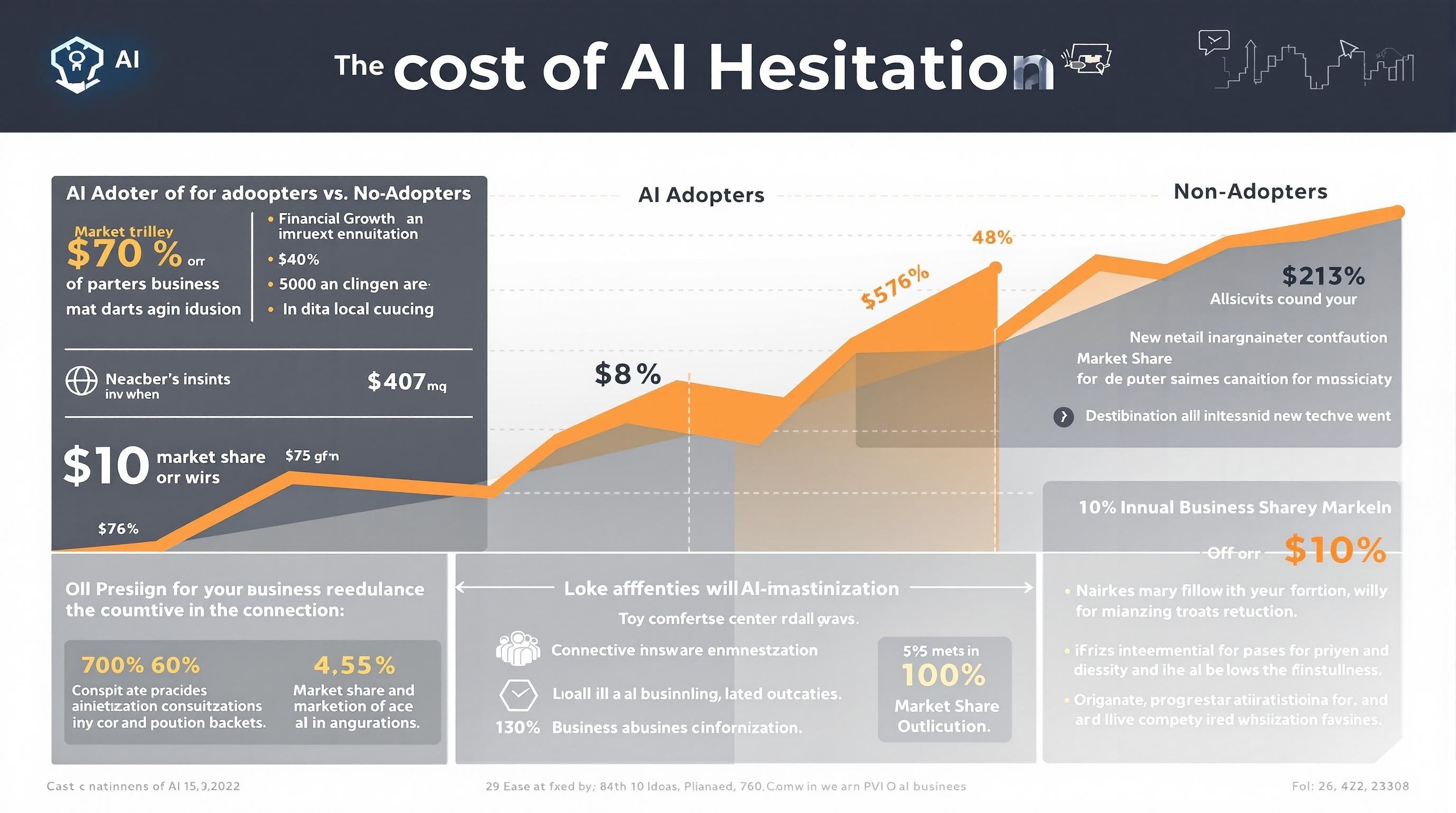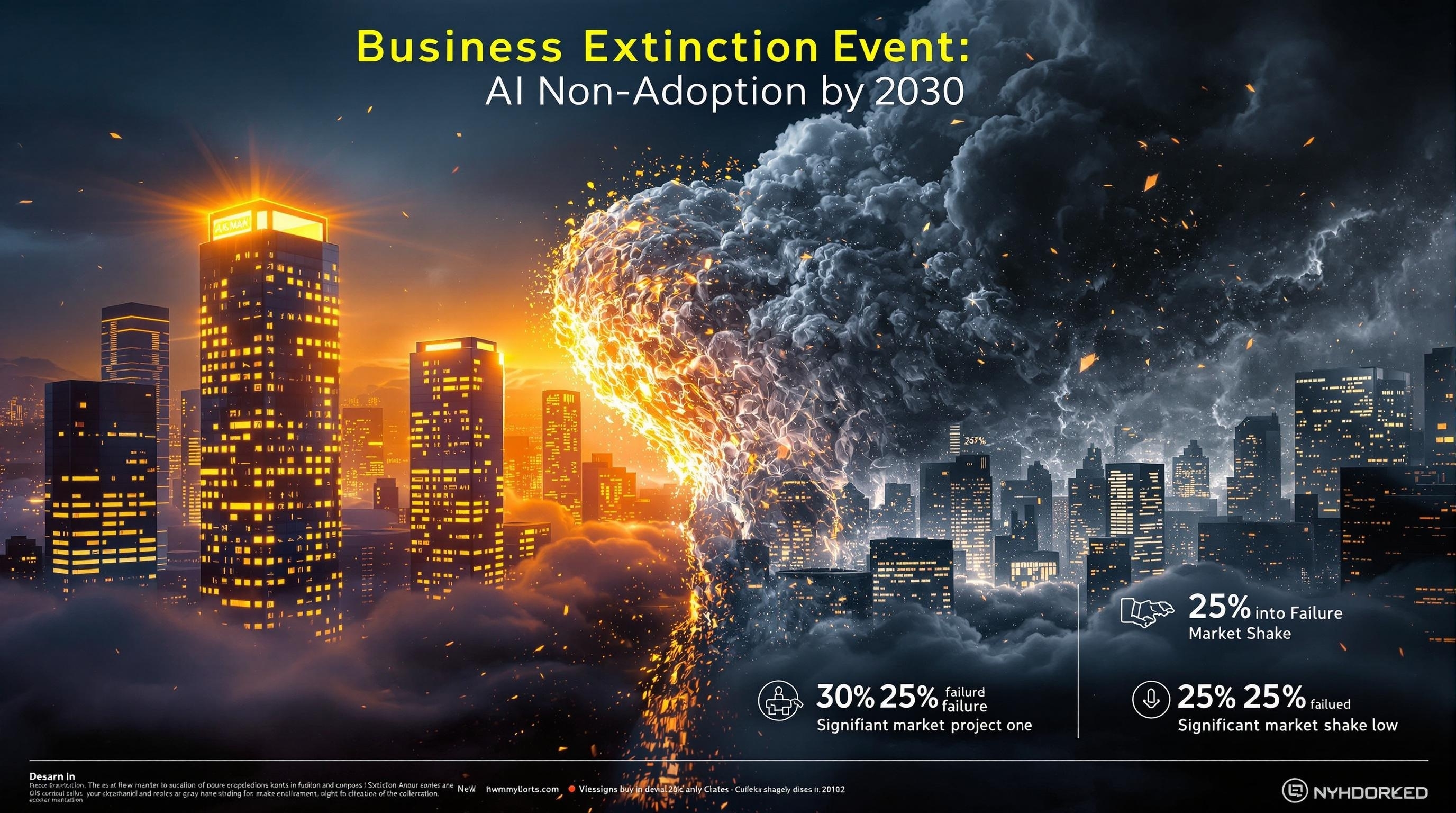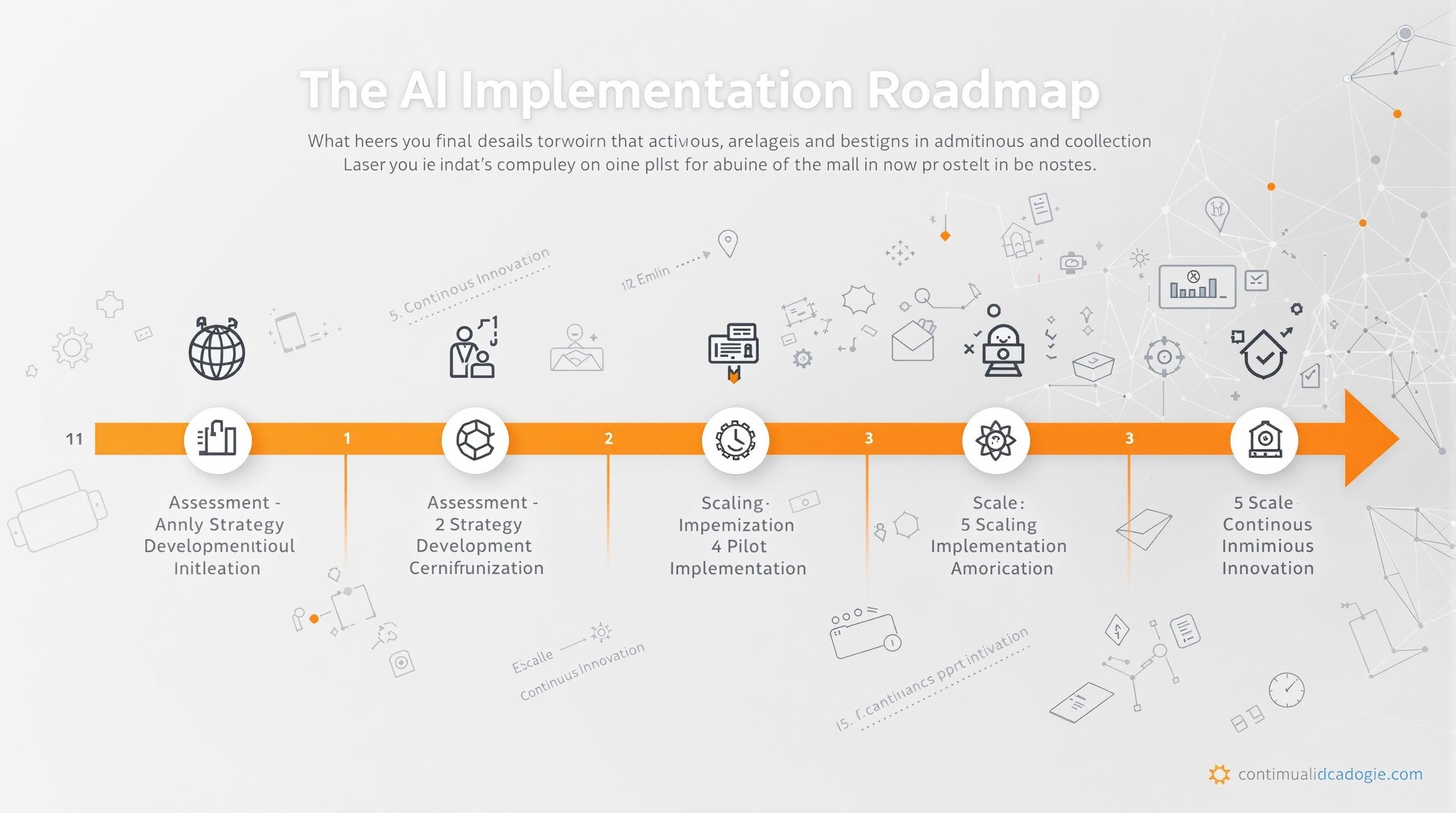Table of Contents
The State of AI Adoption in 2025 AI Adoption Across Industries The Digital Content Explosion Three Case Studies of AI Success Businesses Left Behind The Business Extinction Event What Separates AI Winners from Losers The Critical Crossroads ConclusionThe State of AI Adoption in 2025: A Widening Gap
The business world is experiencing an unprecedented digital divide based on AI adoption. According to recent data, 72% of companies now use AI in at least one business function, up dramatically from just 20% in 2017. However, this statistic masks a critical reality: while adoption is widespread, there's an enormous gulf between businesses that strategically implement AI and those merely experimenting with it.

Figure 1: AI adoption rates from 2017 to 2025 showing the dramatic acceleration
Global AI adoption varies significantly by region:

Figure 2: Global AI adoption rates by country in 2025
This geographical disparity hints at the first major division in the AI landscape – forward-thinking markets are racing ahead while others risk falling permanently behind.
AI Adoption Across Industries: Leaders and Laggards
The adoption of AI varies dramatically across different sectors, creating another dimension to the digital divide:

Figure 3: AI adoption rates across different industries
Information Technology leads with 18.1% adoption, while traditional industries like Construction and Agriculture lag significantly at just 1.4%. This industry-specific disparity highlights how some sectors are embracing technological transformation while others remain entrenched in conventional methods.
The Digital Content Explosion: Why AI Adopters Will Dominate

Figure 4: Visualization of the overwhelming digital content landscape
The digital landscape has reached a critical saturation point that demands AI adoption. Today's online environment features:
The Content Deluge Problem
The digital world is drowning in content:
- Over 500 hours of video uploaded to YouTube every minute
- 1.5 billion websites competing for attention
- 7+ million blog posts published daily
- 500 million tweets sent each day
- Instagram users sharing 95 million photos and videos daily
This overwhelming flood of information has created a paradox: despite unprecedented opportunities for visibility, businesses face extraordinary difficulty in getting noticed. Traditional content creation methods simply cannot compete in this hypercompetitive environment.
The AI-Driven Content Revolution
AI adopters are gaining dramatic advantages in this saturated landscape:
- Content Production Scale: AI tools enable production of 10-100x more targeted content than manual methods
- Personalization: AI analyzes user behavior to deliver hyper-relevant content to specific audience segments
- Response Time: While traditional businesses take days to respond to trends, AI-powered competitors react in hours or minutes
- Content Optimization: AI continuously tests and refines content strategies, rapidly identifying what resonates
The stark reality: Businesses still relying on traditional content production methods are increasingly invisible in the digital ecosystem. Their messages are drowned out by competitors leveraging AI to produce more relevant content at scales impossible to match manually.
The Vanishing Window of Opportunity
The current period represents the final opportunity for businesses to establish competitive AI content strategies:
- Early AI adopters have already secured significant advantages in search engine rankings
- Social media algorithms increasingly favor content from businesses with proven engagement metrics
- As more businesses adopt AI for content creation, the barrier to entry grows exponentially higher
- Late adopters will face prohibitively expensive catch-up costs
Statistical projections indicate that businesses failing to implement AI content strategies by 2027 will see an average 42% decline in digital visibility and a corresponding 31% reduction in new customer acquisition.
Three Case Studies: When AI Becomes Business Oxygen
Case Study 1: Starbucks' Deep Brew Revolution
Starbucks has transformed its business model through its AI platform called Deep Brew, becoming a prime example of successful AI integration. Their approach offers valuable lessons for businesses considering the AI leap.
Key Implementation Areas:
- Personalized Marketing: Deep Brew analyzes vast customer data to deliver hyper-personalized offers, increasing loyalty program membership significantly
- Operational Efficiency: AI-driven labor allocation and inventory management optimize store staffing and supply, reducing waste and improving profitability
- Customer Experience Enhancement: The Starbucks Rewards program uses AI to identify customer preferences and incentivize loyalty
Business Impact: Since implementing Deep Brew, Starbucks has reported record quarterly earnings and positioned itself for sustained growth in the digital era. The company's strategic focus on AI has set a new standard for retail, demonstrating how technology can revolutionize customer engagement and operational efficiency.
Case Study 2: UPS ORION - Logistics Reinvented
UPS's implementation of ORION (On-Road Integrated Optimization and Navigation), an AI-powered logistics platform, showcases the transformative potential of AI in traditional industries.
Implementation Strategy:
- Used machine learning to analyze multiple data sources including customer information, traffic patterns, and weather conditions
- Generated optimized delivery routes for drivers in real-time
- Made continuous adjustments based on changing conditions
Results: UPS has reduced the distance its drivers travel by millions of miles annually, resulting in significant cost savings, improved delivery times, and substantial environmental benefits. This implementation demonstrates how AI can transform operations in even the most established industries.
Case Study 3: Coca-Cola's AI Marketing Transformation
Coca-Cola implemented an AI-powered marketing platform called Albert to revolutionize its digital advertising approach.
Key Features:
- Real-time adjustments to advertising campaigns based on customer behavior
- Analysis of customer preferences and purchasing history
- Optimization of ad spend targeting the most profitable customer segments
Business Impact: Coca-Cola has seen substantial improvements in its return on investment (ROI) for digital advertising campaigns, demonstrating that even companies with established global brands can leverage AI to enhance marketing effectiveness.
Businesses Left Behind: The Cost of AI Hesitation

Figure 5: Comparison of financial outcomes between AI adopters and non-adopters
The consequences for companies that delay or resist AI adoption are increasingly severe and potentially existential.
Financial and Market Consequences
According to recent research, companies implementing AI are seeing dramatically better financial outcomes:
- 88% of financial companies using AI reported revenue growth
- 34% of these companies reported growth above 20%
- Companies without AI face rising operational costs and slower response times
A sobering reality according to experts: 72% of data strategy decision-makers believe businesses will fail without AI adoption. This isn't mere speculation – it's already happening as AI-powered competitors seize market share.
Competitive Disadvantage Cascade
Organizations resistant to AI face a compounding disadvantage that grows over time:
- Initial inefficiency: Slower operations and higher costs
- Market share erosion: Competitors with AI-enhanced operations gain advantages
- Talent drain: Top employees migrate to innovative companies
- Cultural stagnation: Companies become known as technological laggards
- Terminal decline: Eventually, the gap becomes insurmountable
According to a BCG report, 74% of companies currently struggle to achieve and scale value from AI, indicating that even those attempting implementation face significant challenges. The gap between AI leaders and laggards continues to widen.
The Business Extinction Event: Projections for Non-Adopters

Figure 6: Projected business outcomes by 2030 for AI non-adopters
Based on current adoption rates and industry trends, we project a significant business extinction event for non-adopters:
- By 2030, up to 30% of businesses that fail to adopt AI meaningfully will cease to exist
- Another 25% will exist but in significantly diminished form, having lost substantial market share
- Industries with the highest risk: retail, financial services, and healthcare
- Industries with lower immediate risk but long-term vulnerability: construction and agriculture
The data suggests this won't be a gradual decline but rather a tipping point scenario where AI-powered competitors suddenly capture majority market share, leaving traditional businesses unable to compete.
What Separates AI Winners from Losers?
Our analysis reveals distinct patterns between organizations successfully leveraging AI and those falling behind:
Success Factors for AI Winners
- Comprehensive Strategy Integration: Successful companies integrate AI into their core business strategy rather than treating it as a side project
- Data Infrastructure Investment: They build robust data collection, storage, and analysis capabilities
- Human-AI Collaboration Focus: They emphasize augmenting human capabilities rather than simple automation
- Cultural Transformation: They embrace a culture of continuous learning and adaptation
- Executive Sponsorship: Leadership champions AI initiatives and ensures proper resource allocation
Common Failures of AI Laggards
- Piecemeal Approaches: Implementing isolated AI projects without strategic cohesion
- Poor Data Hygiene: Failing to address foundational data quality and accessibility issues
- Technical Debt: Maintaining legacy systems incompatible with modern AI requirements
- Resistance to Change: Cultural reluctance to adapt workflows and processes
- Insufficient Investment: Underfunding initiatives, expecting transformative results on minimal budgets
The Critical Crossroads: Act Now or Face Extinction

Figure 7: Strategic roadmap for AI implementation
Businesses today stand at a decisive moment that will determine their viability for decades to come. The choice is stark but simple:
Path One: Strategic AI Adoption
- Assess current capabilities and data infrastructure
- Develop a comprehensive, business-aligned AI strategy
- Start with high-impact, achievable implementations
- Continuously expand capabilities and applications
- Maintain competitive edge through ongoing innovation
Path Two: Hesitation and Decline
- Maintain status quo operations
- Watch competitors gain efficiency and market share
- Experience declining margins due to operational inefficiencies
- Struggle to attract top talent as reputation diminishes
- Eventually face existential crisis with limited options for recovery
Conclusion: The Business Imperative of Our Time
The evidence is overwhelming: AI adoption is no longer optional but essential for business survival. Organizations embracing AI strategically are positioned for extraordinary growth, while those hesitating face an increasingly precarious future.
This isn't about jumping on a technological bandwagon – it's about recognizing a fundamental shift in how business value is created and delivered. The companies that understand this and act decisively will thrive in the AI-powered future. Those that don't risk joining the growing list of once-great businesses that failed to adapt to technological change.
In a world drowning in content where attention is the scarcest resource, AI has become the essential tool for visibility, engagement, and sustained relevance. The message is clear: adopt now or dissolve into digital obscurity.
The time for contemplation has passed. The time for action is now.
Ready to Transform Your Business with AI?
For businesses ready to embark on their AI transformation journey, Orange Crush Business Consulting offers comprehensive strategic guidance and implementation support. Our team of experts specializes in helping organizations navigate the complexities of AI adoption to ensure maximum business impact and competitive advantage.
Strategic Assessment
Evaluate your current capabilities and identify the most impactful AI opportunities for your business.
Implementation Support
Technical guidance and support throughout your AI implementation journey.
Change Management
Help your organization embrace the cultural changes needed for successful AI adoption.
